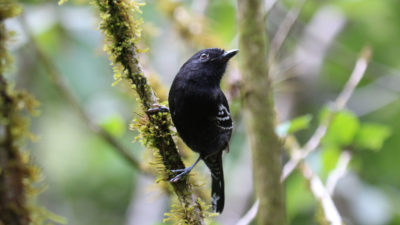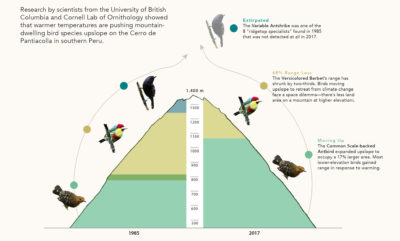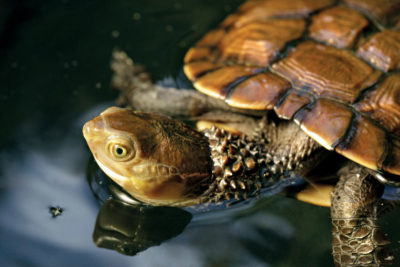A shift in home range by a handful of bird species along an obscure ridge in the Peruvian Andes might once have seemed like sleepy stuff, even to ecologists. Instead, it made headlines last month when researchers reported that the birds’ uphill push for cooler terrain has already resulted in population losses for most species and the probable extirpation of five species that were common at the top of the ridge just 33 years ago.
It was some of the strongest evidence yet for the long-standing prediction by scientists that climate change will lead — is leading now — to widespread loss of wildlife. University of British Columbia ecologist Ben Freeman and his co-authors summed up their findings with a chilling metaphor: Mountain birds, they wrote, are “riding an escalator to extinction.”
The study, in the Proceedings of the National Academy of Sciences, didn’t report any actual extinctions. The Cerro de Pantiacolla rises to a maximum height of only 4,642 feet, and the birds that disappeared from the ridgetop persist on higher and larger mountains — in effect, on other escalators — elsewhere in the area. Reliable scientific evidence that climate change has caused actual extinctions is in fact scarce so far, despite projections by climate modelers that such extinctions are likely. The only known example is a marsupial called the Bramble Cay melomys, which vanished sometime after 2009 from a low-lying island off northern Australia, after sea level rise and extreme weather caused repeated inundation of its habitat.
A shift in the range of a species can mean the introduction of new rivalries and the unraveling of ecosystems.
But the new study from Peru lends support to the predictions being made by climate modelers. It also fits into a rapidly expanding body of evidence that plants and animals everywhere are on the move as they struggle to adjust to climate change. The ecological upheaval is “happening right now and it will almost certainly continue to happen,” says Freeman, lead author of the Peru study, and “there is an immediacy to something happening right before our eyes that’s different from a study saying, ‘this is what it’s going to be like in 2100.’”
When plants and animals move uphill, they can lose habitat, simply because mountains become smaller the higher you climb. A shift in range can also mean the loss of old partnerships, the introduction of new rivalries, and the unraveling of entire ecosystems. Some of these emerging struggles are small-scale and tentative, a bit like a budding workplace rivalry: On Whiteface Mountain in northern New York, for instance, Bicknell’s thrush is state-listed as a species of “special concern.” (A petition to list it under the federal Endangered Species Act recently failed.) It’s a medium-sized brown bird with a speckled throat, and 40 years ago it had the mountaintop to itself. But climate change means that it must now share that landscape with the American robin and Swainson’s thrush, which have both moved in from downhill. Swainson’s thrush responds aggressively to the calls of Bicknell’s thrush. Whether it will eventually push Bicknell’s out of its old habitat may depend on a host of variables from nesting behavior to food preferences.
Other climate-induced range shifts are more like a hostile corporate takeover and can happen with astonishing speed and scale. In western Australia, for instance, ocean temperatures have risen steadily since the 1970s. But as recently as 2010, luxuriant kelp forests still dominated the shallows along 500 miles of coastline north of Perth. Then three exceptionally warm summers in a row wiped out 43 percent of the kelp. By the time the heat waves finally ended, tropical and sub-tropical fish had moved into what was formerly temperate habitat. They nibbled the kelp down to nothing as it attempted to re-sprout, leading to an ecological “regime shift.” The likelihood now is that “rapid local kelp extinction” will progress poleward down thousands of miles of coastline, according to a 2016 study in Science. And since kelp is a major nursery for marine productivity, that “would devastate lucrative fishing and tourism industries worth more than $10 billion (Australian) per year,” along with “catastrophic consequences” for thousands of endemic species.
The range shifts now in progress don’t necessarily stick to the predictable pattern of species heading uphill, or toward the poles, in search of cooler weather. When a team of researchers looked at three sites on protected federal lands in California’s Sierra Nevada, for instance, they found that about half the bird species had moved upslope over the previous 80 years, apparently in response to warming temperatures. But some species had moved downslope, because of increased precipitation — and still others didn’t move at all, or moved upslope in one location and down in another as local climate conditions dictated.
One emerging pattern is that climate change appears to displace tropical species more than their temperate counterparts, though the temperate zone has experienced greater warming. That may be because temperate zone plants and animals already live with “these dramatic fluctuations,” says Freeman. “They have to be able to deal with winter and summer. So it makes sense that a slight change in temperature might not be as consequential.”
Predictions about how or whether species will move can shape the debate about when to intervene to save them.
Species living in the canopy of tropical rainforests may also be pre-adapted to temperature change, according to a 2017 study in the journal Global Ecology and Biogeography, because their treetop habitat already heats up and cools down so much over the course of the daily cycle. In one study of a rainforest in Panama, ants living in the canopy tolerated temperatures 3.5 to 5 degrees Celsius (6.3 to 9 degrees Fahrenheit) warmer than ground-dwelling species could handle. That suggests lowland species might be more inclined “to shift to mid-elevation, and mid-elevation species to high elevation,” as a first line of defense against climate change, says lead author Brett Scheffers, “and high-elevation species go extinct.” It also suggests the potential for what he calls “flattening forests,” with treetop species descending in search of cooler temperatures, leading to sudden overcrowding in some habitats.
“We are just now starting to see research coming out that is describing the effect of climate changes on species interactions,” says Scheffers, a University of Florida ecologist. “Understanding how species interact is really complicated. Trying to understand species in a tropical rainforest, where you have millions of variables … it makes your head hurt just thinking about it.” And yet being able to make reliable predictions about how or whether species will move can be essential for conservation planning — for instance, in deciding which habitats and corridors to protect for the climate 50 or 100 years in the future.
Scientists in Australia have relocated the western swamp tortoise to a new habitat south of its original range in one of the first cases of “assisted colonization.” Perth Zoo
Those predictions can also shape the debate about when to intervene to save a species. In a controversial step known as “assisted colonization,” conservationists in western Australia have already relocated one species, the critically endangered western swamp tortoise, to a new habitat several hours south of its original home range, where it was threatened by urban development and sharply reduced water supply. But that kind of effort requires deep understanding of how the species lived in its old home and how it is likely to interact with other species in its new one. Conservationists, burned by past species introductions, are deeply conservative about assisted colonization. And yet a long list of other species, like a New Zealand bird called the hihi, face the loss of traditional habitats due to climate change.
“We are just starting to see extirpations,” says Scheffers. “The worry is not just that it may happen, but that it may pick up speed. You have all these species interacting, and now climate change is beginning to remove them. It’s like a big Jenga game,” a tower made of wooden blocks where the trick is to pull out the lower pieces one by one get without bringing down the whole thing. “You wonder not only when it’s going to collapse, but what the hell is going to replace it. That should be alarming, and not just to people who care about biodiversity,” he adds. “The exact same changes are also occurring in agriculture and forestry.”
Scientists trying to make sense of these changes now increasingly talk about “no-analog communities” — ecological communities unlike any seen before. But the more frightening reality, adds Freeman, is that we may be facing a “no-analog future.”





